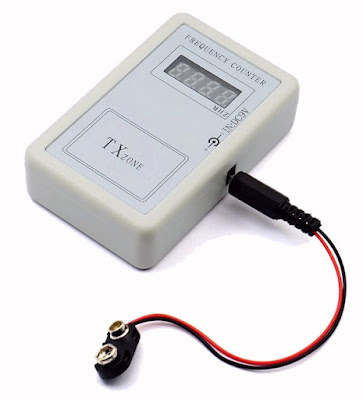Operation of wireless remote controls
Which wireless remote controls are involved?
There are a lot of wireless remote controls in most households. Think of the remote controls of multimedia equipment, home automation, motion sensors, doorbells, mobile toys, garage door openers, air conditioners, weather stations, burglar alarm systems and of course car keys.
Those devices operate on one of the following systems:
- Modulation of infrared light.
- Modulation of a transmission frequency in the higher MHz range.
The device discussed in this review can only be used for testing devices that work according to the second system.
The carrier frequencies
All these systems have transmitters that emit electromagnetic waves with frequencies between 300 MHz and 450 MHz. This transmission frequency is called the 'carrier wave'. European cars generally use keys with a frequency of 433 MHz or 434 MHz. For American or Asian models, the frequency 315 MHz is used. The Sonoff and KlickOnKlickOff systems and numerous clones thereof all work with a carrier frequency of 433.5 MHz. The outdated, but well-known X10 protocol uses a carrier wave with a frequency of 433.92 MHz in Europe and 310.00 MHz in America.
Why is 433 MHz so often used?
The 433 MHz frequency band has been made available to anyone without license for wireless digital low-power communication between devices such as sensors, weather stations, garage door openers, wireless doorbells and home automation. That is why all officially approved remote controls must use this frequency.
It is true that nowadays a carrier wave of 868 MHz is also used, for example by all devices that work according to the Z-wave protocol, but because this test device is not suitable for this, we do not consider this frequency.
Communication works with Amplitude Shift Keying
These devices operate with 100 % amplitude modulation. The carrier wave is either present or absent. For example, you can agree that the presence of the carrier corresponds to the transmission of a digital 'H'. The absence of this carrier wave then means that a digital 'L' is being transmitted. This system is called 'Amplitude Shift Keying', abbreviated to ASK. Due to the lack of bidirectional communication and encryption, the communication protocols are simple in nature.
 |
| The principle of Amplitude Shift Keying or ASK. (© 2022 Jos Verstraten) |
Communication with short telegrams is mandatory
There are, perhaps without you knowing, undoubtedly a lot of devices in your area that transmit and receive on such frequencies. Think of your neighbors' wireless doorbell, your own burglar alarm and the garage door opener of your other neighbors. Because these can of course interfere with each other, it is prohibited that these devices constantly transmit signals. Let's say you have a weather station that communicates wirelessly with an outdoor thermometer. That thermometer will send the instantaneous temperature every ten minutes, in the hope that its base station will receive this transmission and be able to filter the temperature out. Such a pulse train of signals is called a 'telegram'. A telegram always consists of two words. The first word contains a unique ID or address code, which tells the receiver that 'his' sender is transmitting. The second word contains the data that the transmitter must send, for example the temperature.
It is allowed that the sender sends his telegram a few times in succession, so that the chance is almost 100 % that the receiver will receive the message.
Thanks to this communication via very short telegrams with IDs, you can use both wireless transmitters and receivers in your home, install a wireless weather station and use a garage door opener without these three systems getting in each other's way.

Difficult to troubleshoot such systems
If your garage door no longer responds to the handheld transmitter, you must investigate where the fault is. If replacing the battery in the transmitter does not offer a solution, the transmitter may be defective, but it could also be a fault in the receiver. However, troubleshooting such systems with your multimeter or oscilloscope is impossible. This has everything to do with the fact that both of these measuring devices cannot pick up amplitude shift keying signals from the air. Moreover, after a button is pressed, a transmitter only sends out telegrams for a few milliseconds and it's not easy to detect the presence or absence of this short pulse train with a measuring device.
The Winbang remote control tester
How it works
This device is a real solution for anyone who regularly has to look up malfunctions in the discussed remote controls. The tester is in fact able to receive the telegram that a transmitter transmits and to derive the value of the carrier wave from it. This is shown numerically on the built-in display until you reset the device. So if you hold a transmitter near the Winbang and press the transmitter button, if it is working properly, the transmitter frequency will appear on the display. For example, in the video below you can see how we use the Winbang device to test a wall transmitter of the (old) KlickOnKlickOff system.
Manufacturer, suppliers and prices
The device is offered under various manufacturers' names, but the name 'Winbang' is most often mentioned, so we have adopted this name. If you google 'Frequency Counter 250-450MHZ' you will find dozens of offers. The cheapest supplier we found is the 'Vehicle Tool Store' on AliExpress who will supply a copy of the Winbang tester for just €12.62 with no extra shipping costs. Of course you can also pay a lot more for it. A company like Fruugo.nl asks no less than € 54.00 for it!
The appearance of the remote control tester
In the photo below you can see what is delivered for your twelve euros. The tester is housed in a plastic case of approximately 9.0 by 6.0 by 2.5 cm³ and weighs only 65 grams. In the right side there is a small connector for the supply voltage of 9.0 Vdc. For this, a short cord with a battery clamp for a 9 V battery is included. The device has no buttons, you turn it on by connecting the battery and turn it off by disconnecting the battery.
 |
| The Winbang remote control tester. (© AliExpress) |
A point of critic
Admittedly, for a price of twelve euros we should not expect much. But we still wonder why the designers didn't opt for a slightly larger housing that fits the battery. The fiddling with the battery hanging loose is amateurish and completely unworthy of a modern device. In addition, one small cheap push button would make working with the device considerably more pleasant.
The technical specifications
According to the suppliers, this tester has the following specifications:
- Supply voltage: 7.5 Vdc ~ 10.0 Vdc
- Supply current at indication: 51 mA
- Standby current: 40 mA
- Frequency Range: 250.0 MHz ~ 450.0 MHz
- Test distance: 10 cm max.
- Dimensions: 92 mm x 56 mm x 24 mm
The electronics in the Winbang remote control tester
The two parts of the housing are secured with only two screws. The PCB was therefore quickly photographed, see the figure below. On the back of the PCB we recognize a 78L05 stabilizer, which reduces the 9 Vdc supply voltage to 5 Vdc. With three capacitors, the voltages are additionally smoothed out and decoupled. A copy of the EM78P156, an 8 bit microcontroller from the Taiwanese company Elan, is prominently displayed on the front of the PCB. Next to this chip is a small chip with the label 8522S. Googling this number does not yield much. The only thing that comes close is the DN8522S-A from Panasonic. That is a 1.7 GHz pre-scaler for use with central antenna TV systems. It is of course possible that such a prescaler is indeed used to reduce the frequency of the received transmission signal to a value that is manageable by the microcontroller. The DN8522S-A can be set to frequency division factors of 64, 128 and 256.
Underneath these two chips is a large loop-shaped track that undoubtedly serves as an antenna and is coupled via capacitors and/or resistors to the chip with the inscription 8522S.
As the third and last chip we recognize a HEF4069UBT. That is a hex inverter from the standard CMOS family.
 |
| The PCB in the Winbang remote control tester. (© 2022 Jos Verstraten) |
Working with the Winbang remote control tester
Super easy and fast
As the video at the beginning of this article shows, working with this device is super easy. Keep the tester near the transmitter. The display shows '-----'. Now activate the transmitter. If it works, you will immediately see the value of the carrier frequency. It will remain on the display until you remove the battery.
The range of the tester
A value of 10 cm is mentioned in the specifications. Our specimen is much more sensitive. When testing wall switches from KlickOnKlickOff, the tester still responds well if there is a distance of 30 cm between the switch and the case of the Winbang tester. Those KOKO transmitters are apparently powerful, because a test of the handheld transmitter of our garage door does indeed yield a much smaller sensitivity. The transmitter must be placed on the rectangular frame labeled 'TX zone' of the tester in order to obtain a stable and correct frequency response.

The accuracy and bandwidth of the tester
 |
| Testing the accuracy at 400.0000 MHz. (© 2022 Jos Verstraten) |
The bandwidth indeed goes from 250.0 MHz to 450.0 MHz and no Hz more or less. Apparently these values are fixed in the firmware as extreme limits of the range. We cannot detect any deviations within this range, the tester works fine.


